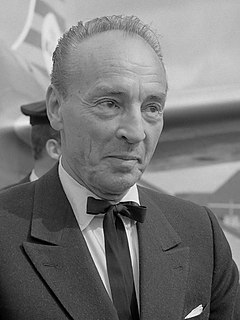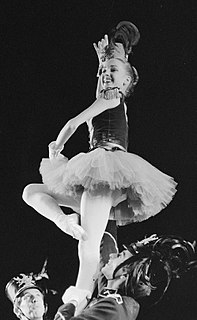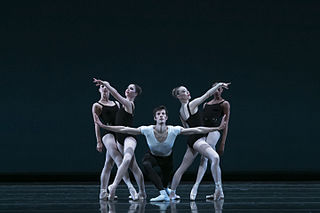
George Balanchine was an American ballet choreographer who was one of the most influential 20th-century choreographers. Styled as the father of American ballet, he co-founded the New York City Ballet and remained its Artistic Director for more than 35 years.

Apollo is a neoclassical ballet in two tableaux composed between 1927 and 1928 by Igor Stravinsky. It was choreographed in 1928 by twenty-four-year-old George Balanchine, with the composer contributing the libretto. The scenery and costumes were designed by André Bauchant, with new costumes by Coco Chanel in 1929. The scenery was executed by Alexander Shervashidze, with costumes under the direction of Mme. A. Youkine. The American patron of the arts Elizabeth Sprague Coolidge had commissioned the ballet in 1927 for a festival of contemporary music to be held the following year at the Library of Congress in Washington, D.C.
Le Bourgeois Gentilhomme refers to two different ballets by George Balanchine set to Richard Strauss's Concert Suite (1917), with a libretto after Molière's 17th-century comédie-ballet of the same name.
The Suzanne Farrell Ballet is a ballet company housed at the Kennedy Center, Washington, D.C., and founded in 2000 by Suzanne Farrell, one of George Balanchine's most celebrated ballerinas, and a former New York City Ballet principal dancer. Until 2017, the Suzanne Farrell Ballet was a full-fledged company produced by the Kennedy Center and had performed there since 1999 in addition to presenting extensive national and international tours. In September 2016, the Center announced that the company would be disbanding at the end of 2017, citing "possibilities of new expansion" and indicating that Farrell would likely return to "full-time teaching."
Episodes is a two-part ballet made by Martha Graham and George Balanchine to Anton von Webern's Symphony, Op. 21, Five Pieces, Op. 10, Concerto, Op. 24, and the Ricercata in Six Voices from Bach's Musical Offering, which Webern had arranged in homage to Bach, as Balanchine conceived the ballet as one to Webern. The premiere took place under the auspices of the Ballet Society on 19 May 1959 at City Center of Music and Drama, New York, with scenery and lighting by David Hays; the conductor was Robert Irving.
The Singapore Dance Theatre is Singapore's national dance company, founded in 1988 by Anthony Then and Goh Soo Khim. It made its debut in June 1988 at the Singapore Festival of The Arts and received its first arts patronage by the then-Deputy Prime Minister, Mr Ong Teng Cheong. The Artistic Director of the company is Janek Schergen.

Suki Schorer is an American ballet dancer, ballet mistress, teacher, and writer. She danced with George Balanchine's New York City Ballet from 1959 to 1972. Suki Schorer teaches at the School of American Ballet, the official school of the New York City Ballet and is a Balanchine Trust répétiteur.
Chaconne is a ballet made by New York City Ballet co-founder and ballet master George Balanchine to ballet music from Gluck's Orfeo ed Euridice. The premiere took place Wednesday, 22 January 1976 at the New York State Theater, Lincoln Center, with lighting by Ronald Bates; Robert Irving conducted. Chaconne was danced in practice clothes at its premiere; Karinska's costumes were added in the spring season.

The Four Temperaments is a ballet made by New York City Ballet co-founder and ballet master George Balanchine to music he commissioned from Paul Hindemith for the opening program of Ballet Society, immediate forerunner of City Ballet.
Liebeslieder Walzer is a ballet by New York City Ballet co-founder and ballet master George Balanchine, based on the Brahms' Liebeslieder Walzer, Op. 52, and their sequel Neue Liebeslieder, Op. 65.
Who Cares? is a ballet made by New York City Ballet's co-founder and founding choreographer George Balanchine to songs by George Gershwin in an orchestration by Hershy Kay. The premiere took place on Saturday, February 7, 1970, at the New York State Theater, Lincoln Center with costumes by Barbara Karinska and lighting by Ronald Bates; it was at first performed without décor but from November 1970 with scenery by Jo Mielziner.
Episodes may refer to:
Monumentum pro Gesualdo is a ballet by the New York City Ballet (NYCB) co-founder and balletmaster George Balanchine to music by Igor Stravinsky composed in honor of the 400th birthday of the composer Carlo Gesualdo and consisting of Stravinsky's orchestrations of Gesualdo's madrigals. The premiere took place on Wednesday, November 16, 1960, at City Center of Music and Drama, New York, with scenery and lighting by David Hays and was conducted by Robert Irving. The composer conducted the score's orchestral premiere on Tuesday, September 27, 1960, for the XXIII Venice Music Festival at La Fenice.
Choreographer George Balanchine's production of Tchaikovsky's ballet The Nutcracker has become the most famous stage production of the ballet performed in the U.S. It uses the plot of the Alexandre Dumas, père, version of E.T.A. Hoffmann's tale, The Nutcracker and the Mouse King (1816). Its premiere took place on February 2, 1954, at City Center, New York, with costumes by Karinska and sets by Horace Armistead. It has been staged in New York every year since 1954, and many other productions throughout the United States either imitate it, or directly use the Balanchine staging. However, although it is often cited as being the production that made the ballet famous in the U.S., it was Willam Christensen's 1944 production for the San Francisco Ballet which first introduced the complete work to the United States.